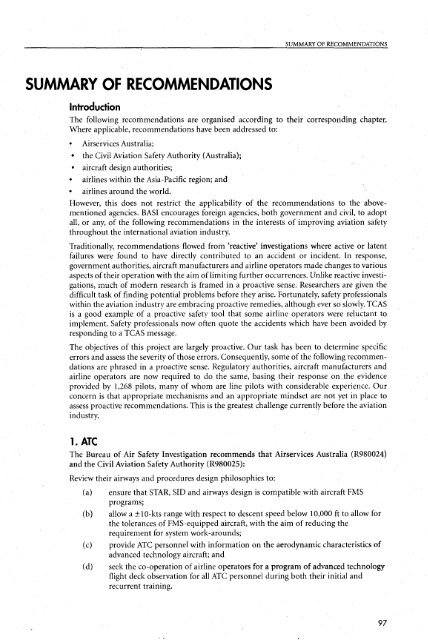Advanced Technology Aircraft Safety Survey Report - Australian ...
Advanced Technology Aircraft Safety Survey Report - Australian ...
Advanced Technology Aircraft Safety Survey Report - Australian ...
You also want an ePaper? Increase the reach of your titles
YUMPU automatically turns print PDFs into web optimized ePapers that Google loves.
SUMMARY OF RECOMMENDATIONS<br />
SUMMARY OF RECOMMENDATIONS<br />
Introduction<br />
The following recommendations are organised according to their corresponding chapter.<br />
Where applicable, recommendations have been addressed to:<br />
Airservices Australia;<br />
the Civil Aviation <strong>Safety</strong> Authority (Australia);<br />
aircraft design authorities;<br />
airlines within the Asia-Pacific region; and<br />
airlines around the world.<br />
However, this does not restrict the applicability of the recommendations to the abovementioned<br />
agencies. BAS1 encourages foreign agencies, both government and civil, to adopt<br />
all, or any, of the following recommendations in the interests of improving aviation safety<br />
throughout the international aviation industry.<br />
Traditionally, recommendations flowed from ‘reactive’ investigations where active or latent<br />
failures were found to have directly contributed to an accident or incident. In response,<br />
government authorities, aircraft manufacturers and airline operators made changes to various<br />
aspects of their operation with the aim of limiting further occurrences. Unlike reactive investi-<br />
gations, much of modern research is framed in a proactive sense. Researchers are given the<br />
difficult task of finding potential problems before they arise. Fortunately, safety professionals<br />
within the aviation industry are embracing proactive remedies, although ever so slowly. TCAS<br />
is a good example of a proactive safety tool that some airline operators were reluctant to<br />
implement. <strong>Safety</strong> professionals now often quote the accidents which have been avoided by<br />
responding to a TCAS message.<br />
The objectives of this project are largely proactive. Our task has been to determine specific<br />
errors and assess the severity of those errors. Consequently, some of the following recommen-<br />
dations are phrased in a proactive sense. Regulatory authorities, aircraft manufacturers and<br />
airline operators are now required to do the same, basing their response on the evidence<br />
provided by 1,268 pilots, many of whom are line pilots with considerable experience. Our<br />
concern is that appropriate mechanisms and an appropriate mindset are not yet in place to<br />
assess proactive recommendations. This is the greatest challenge currently before the aviation<br />
industry.<br />
1. ATC<br />
The Bureau of Air <strong>Safety</strong> Investigation recommends that Airservices Australia (R980024)<br />
and the Civil Aviation <strong>Safety</strong> Authority (R980025):<br />
Review their airways and procedures design philosophies to:<br />
(a) ensure that STAR, SID and airways design is compatible with aircraft FMS<br />
programs;<br />
(b) allow a fl0-kts range with respect to descent speed below 10,000 ft to allow for<br />
the tolerances of FMS-equipped aircraft, with the aim of reducing the<br />
requirement for system work-arounds;<br />
(c) provide ATC personnel with information on the aerodynamic characteristics of<br />
advanced technology aircraft; and<br />
(d) seek the co-operation of airline operators for a program of advanced technology<br />
flight deck observation for all ATC personnel during both their initial and<br />
recurrent training.<br />
97
















